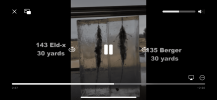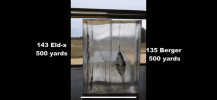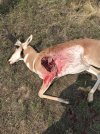Some Bergers have a much larger cavity than others. That's the keyword there too- cavity. These aren't really a "hollow point" as the term is intended to represent. They're just made with an open tip copper jacket.
I've cut apart a lot of them now, and I've seen quite a few noteworthy things. The older VLDs (pre 2011) were a pretty good design and the jackets were pretty uniform in thickness. They worked quite well and there were few issues reported. I just hate how finicky VLDs can be regarding load development.
When the popularity started really growing for heavy for caliber, high BC, bullets, particularly in 7mm, Berger answered the demand. Unfortunately, issues arose from this. The extra length and then the required faster twist rate produced excessive friction and heat and the cores were melting and the bullets were coming apart in flight as a result. Around 2011, Berger "fixed" this issue by slightly thickening the jackets. This process unfortunately made them even thicker at the ogive. As a result, this made them unreliable regarding expansion at lower impact velocities (dipping below like 1800fps especially). This is why a quoted fixed.
A lot of people stopped using Bergers around this time and they started getting a lot of mixed reviews.
Well, after the introduction of the Hybrid ogives, many of those issues have gone away, including the finicky issues with load development. They've added fluting, or ribbing (whatever you want to call it), to the ogive area of the jackets and that has added a level of structural weakness that allows them to still perform well at lower impact velocities. Even the newer VLDs have this fluting/ribbing now.
Bergers, like other non-tipped similarly constructed bullets used for hunting, rely on the cavity to properly initiate and produce the deformation and expansion. The tip buckles back into this cavity upon impact and produces a wide contact surface that in turn allows for more force to act upon it and create more expansion and shedding of weight. This helps to convert energy into hydraulic force and produces massive amounts of wounding.
All that said, there can still be some unreliabilities with VLDs and some of the pointed and smaller caliber hybrids though. This is due to the ogive profiles, ultimately. The VLDs are fully secant and thus more long and narrow. This adds a degree of strength and will resist deformation and buckling. This is why I personally still do not recommend them for hunting applications where impact velocities will dip below 1800fps. Some of the longer and more narrow hybrids can have a similar issue.
One plus about many of the EOLs and pointed hybrids is that the BC is so high, the retained velocity is also high, so when they hit that 1800fps or so threshold, they're still a long ways out and most people would be hunting to distances to where the bullet would still impact at a high enough velocity as a result.
There's more to be said about all this, but I'm trying to be brief and just give a basic idea to consider is all. I'll attach a few pics with different examples for a visual reference.
View attachment 444868View attachment 444869



